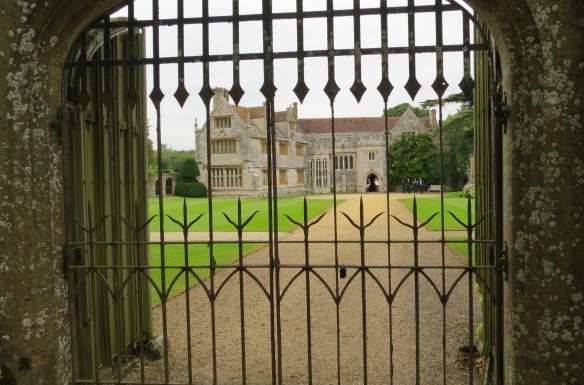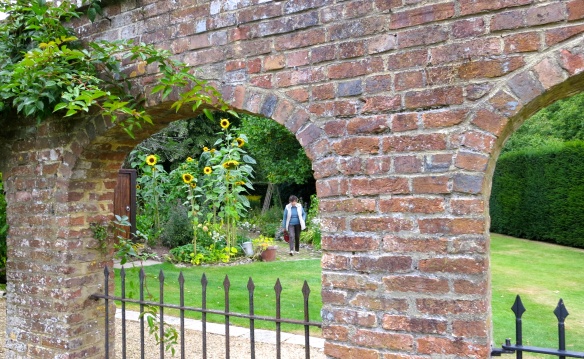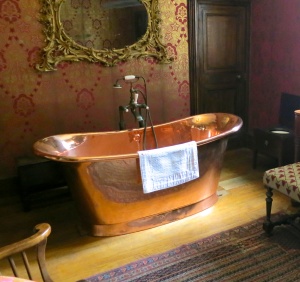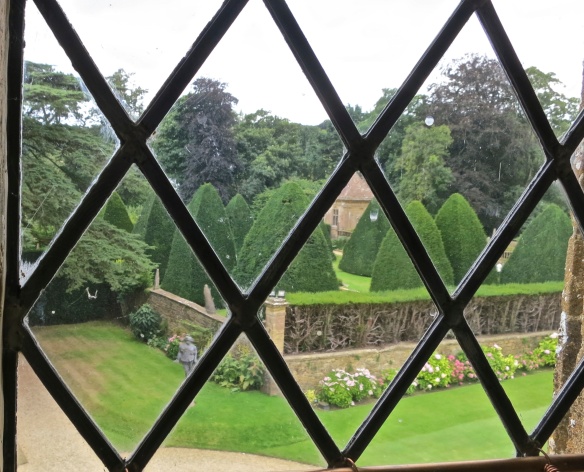On learning of my penchant for history, our friend Margery lent me ‘The Crusades’ by Thomas Asbridge. I began reading it yesterday evening.
As I took a series of photographs in January 1965, at the ripe old age of 22, I thought: ‘these will be an historical record one day’.  Now, nigh on 49 years later, they are. I did not start illustrating these posts until June last year, so when I mentioned on 22nd May that I still had the colour slides I took of the queues for the lying in state of Sir Winston Churchill, I did not add them to the post. I rectified that this morning, by adding five.
Now, nigh on 49 years later, they are. I did not start illustrating these posts until June last year, so when I mentioned on 22nd May that I still had the colour slides I took of the queues for the lying in state of Sir Winston Churchill, I did not add them to the post. I rectified that this morning, by adding five.
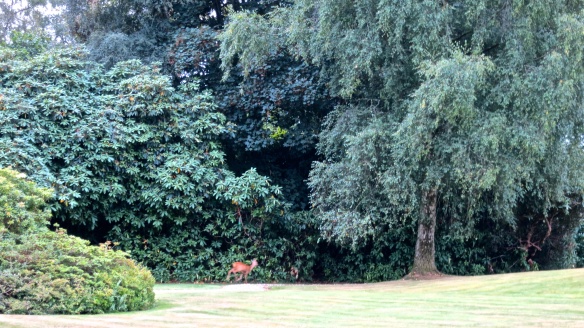 After this a deer made its quite slow, elegant, way across the lawn, until, disturbed by our attention, it fled into its bolt hole.
After this a deer made its quite slow, elegant, way across the lawn, until, disturbed by our attention, it fled into its bolt hole.
 I then walked the two underpasses route, starting at the Malwood Farm end. A summer’s usage by pedestrians and ponies has produced such reasonably clear footpaths as to make my earlier errant efforts at this trip during the waterlogged spring seem somewhat meandering. The farm’s gravel heap is higher, harmonising even better with the pipes upon, and logs beside, it. I reached the Rufus Stone car park in very quick time, just as Bob and Lyndon were preparing to move on.
I then walked the two underpasses route, starting at the Malwood Farm end. A summer’s usage by pedestrians and ponies has produced such reasonably clear footpaths as to make my earlier errant efforts at this trip during the waterlogged spring seem somewhat meandering. The farm’s gravel heap is higher, harmonising even better with the pipes upon, and logs beside, it. I reached the Rufus Stone car park in very quick time, just as Bob and Lyndon were preparing to move on.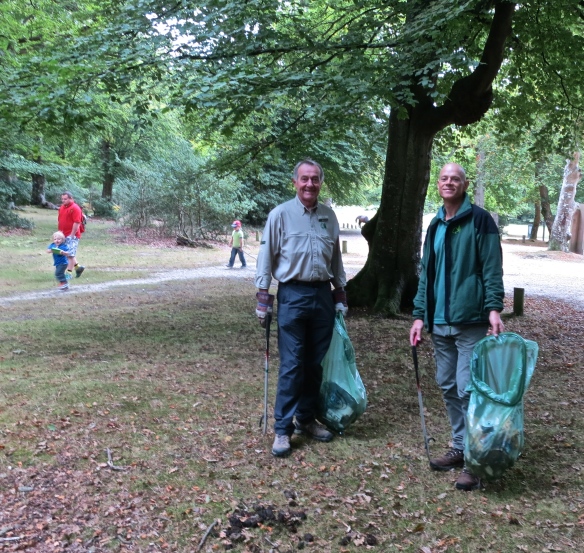 These two friendly men were volunteers for the Forestry Commission, engaged in litter picking. I wondered if the family decanting from a car behind them might render some of their work in vain. I spoke with them for a while, and told them I had seen their equivalent in Morden Hall Park last year. They knew of the National Trust’s similar system.
These two friendly men were volunteers for the Forestry Commission, engaged in litter picking. I wondered if the family decanting from a car behind them might render some of their work in vain. I spoke with them for a while, and told them I had seen their equivalent in Morden Hall Park last year. They knew of the National Trust’s similar system.
Outside Shovel Cottage in Minstead four apples placed on the verge of the road seemed to be harbingers of the season when local residents put out food for the struggling ponies.

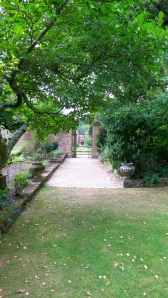 At mid-day we set off, Jackie driving, to Athelhampton Hall in Dorset to visit the privately owned house and gardens.
At mid-day we set off, Jackie driving, to Athelhampton Hall in Dorset to visit the privately owned house and gardens.  It was a dull day and late in the year, but we saw enough of the splendidly designed gardens to know that they will look stunning in spring and summer, when we vowed to return.
It was a dull day and late in the year, but we saw enough of the splendidly designed gardens to know that they will look stunning in spring and summer, when we vowed to return.  First built in 1485, the house has undergone various embellishments over the centuries, yet remains beautifully integrated.
First built in 1485, the house has undergone various embellishments over the centuries, yet remains beautifully integrated.
The garden has been so well designed that wherever you are positioned, as in an open plan house, you are led to another living area. There almost seem to be more rooms in the garden than in the grand house, each one offering an invitation to another. 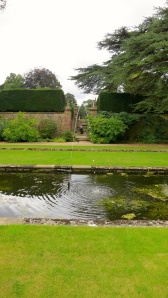 There are more walls than in an open plan house, though. Fountains abound. Through one you can usually see another. Dahlias, Rudbeckia,
There are more walls than in an open plan house, though. Fountains abound. Through one you can usually see another. Dahlias, Rudbeckia,  sunflowers, Hydrangea were blooming.
sunflowers, Hydrangea were blooming. 
 Some roses were still at their best, usually with their companions’ petals carpeting the earth beneath them.
Some roses were still at their best, usually with their companions’ petals carpeting the earth beneath them. 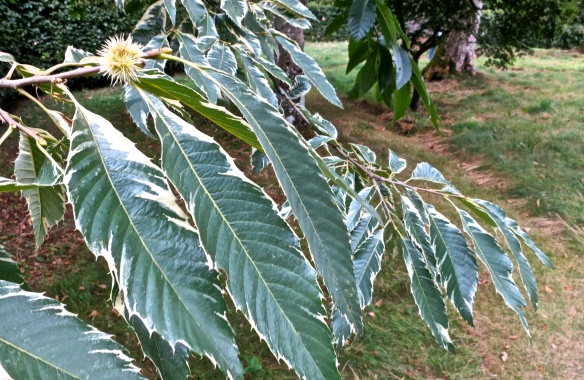 Sweet chestnut shells are developing to protect the nuts they nurture.
Sweet chestnut shells are developing to protect the nuts they nurture.

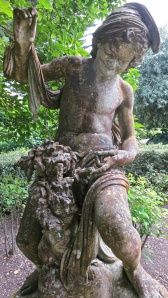 A thirty year old eucalyptus, in gentle pastel colours, sheds its bark and its leaves onto the brick paths around its base, two long roots stretching out like symmetrical tentacles.
A thirty year old eucalyptus, in gentle pastel colours, sheds its bark and its leaves onto the brick paths around its base, two long roots stretching out like symmetrical tentacles.  There are a number of pleached lime colonnades.
There are a number of pleached lime colonnades.
The delightful boy with his dog was just one of the many sculptures enjoying the flowers.
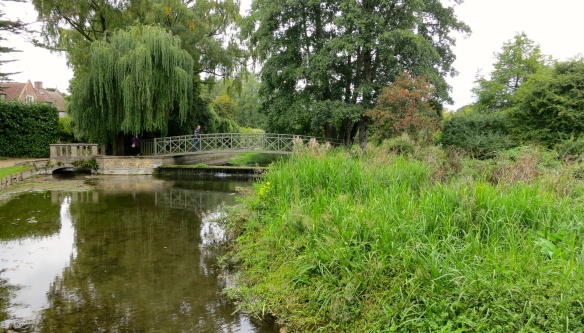 A bridge in the grounds crosses the River Piddle. (That just had to be done, didn’t it?)
A bridge in the grounds crosses the River Piddle. (That just had to be done, didn’t it?)

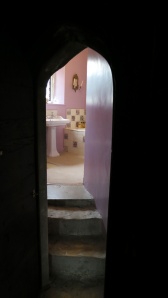 At the entrance to the house I was intrigued by the dates of some of the graffiti. Once inside, we were permitted to take photographs; could roam freely without having to follow a prescribed route; and could, it seemed, sit anywhere.
At the entrance to the house I was intrigued by the dates of some of the graffiti. Once inside, we were permitted to take photographs; could roam freely without having to follow a prescribed route; and could, it seemed, sit anywhere.
There were bathrooms of different periods, one containing a magnificent polished copper bath. It had me wondering about the term ‘copper’ for a tub for washing clothes. The state bedroom had what must have been a rather early en suite.

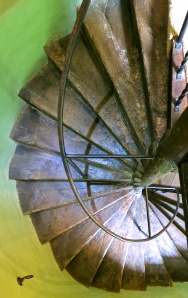 Staircases were from very different periods, and always intriguing. One, an Elizabethan ammonite, led to the gallery where I discovered Marevna. Marevna was a Russian painter who lived in the house from 1948 -1957.
Staircases were from very different periods, and always intriguing. One, an Elizabethan ammonite, led to the gallery where I discovered Marevna. Marevna was a Russian painter who lived in the house from 1948 -1957.  She worked with all the great earlier twentieth century painters, her style embracing various forms, such as cubism and pointillism, to name just two I recognised. Obviously a favourite model, her daughter Marika, was her child with Mexican artist Diego Rivera who, incidentally, numbered the brilliant Frida Kahlo among his many lovers.
She worked with all the great earlier twentieth century painters, her style embracing various forms, such as cubism and pointillism, to name just two I recognised. Obviously a favourite model, her daughter Marika, was her child with Mexican artist Diego Rivera who, incidentally, numbered the brilliant Frida Kahlo among his many lovers.  At the top of the spiral staircase lies the entrance to the gallery, through the door of which can be seen part of her ‘Homage to Friends from Montparnasse’ of 1961.
At the top of the spiral staircase lies the entrance to the gallery, through the door of which can be seen part of her ‘Homage to Friends from Montparnasse’ of 1961.  Her painting of The Great Court hangs on a wall adjacent to one framing a window through which can be seen the real thing.
Her painting of The Great Court hangs on a wall adjacent to one framing a window through which can be seen the real thing.
 When, like father bear, I tested a very comfortable chair, and Jackie decided to photograph me in situ, she found herself at the head of a queue of would-be David Baileys.
When, like father bear, I tested a very comfortable chair, and Jackie decided to photograph me in situ, she found herself at the head of a queue of would-be David Baileys.
After an uneventful drive back Jackie produced a meal of lamb and mint sausages, potato croquettes, onions, mushrooms, cauliflower, cabbage and peas. It only needs a second’s power cut, to which we are prone, for the electric cooker to be thrown out. By this, I mean, its operation is upset. Mind you, it sometimes is at serious risk of being ejected through the kitchen window. The instruction manual has to be consulted, and much fiddling undergone if the food is ever to burn. We had one a couple of days ago. However, it was sorted, otherwise we wouldn’t have had our sausages. Mine went down well with the rest of yesterday’s Sicilian wine, and Jackie’s with her Belgian beer.


